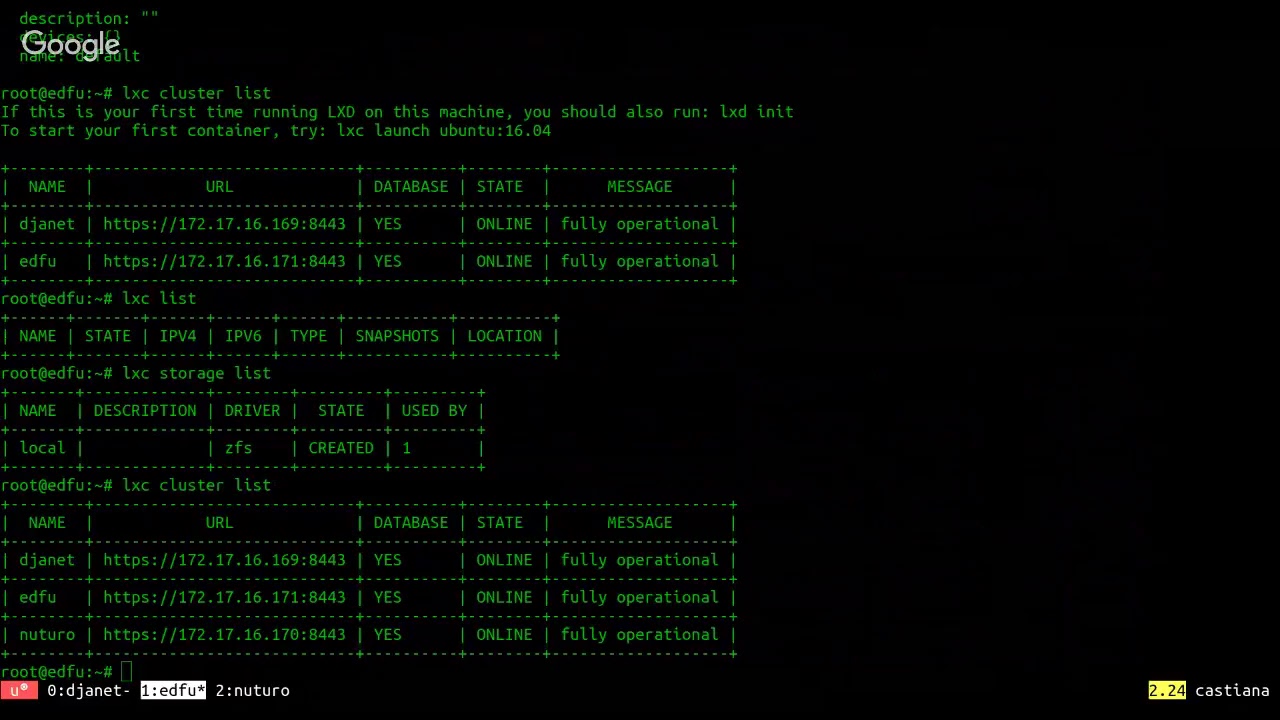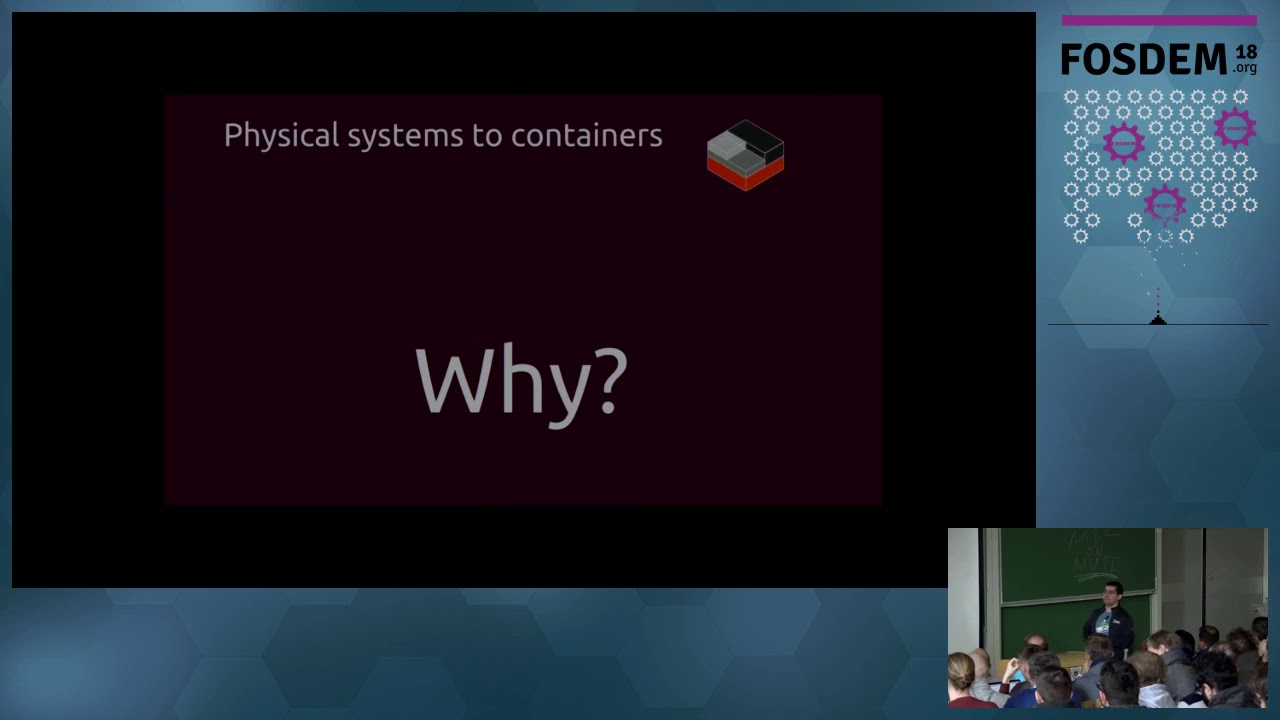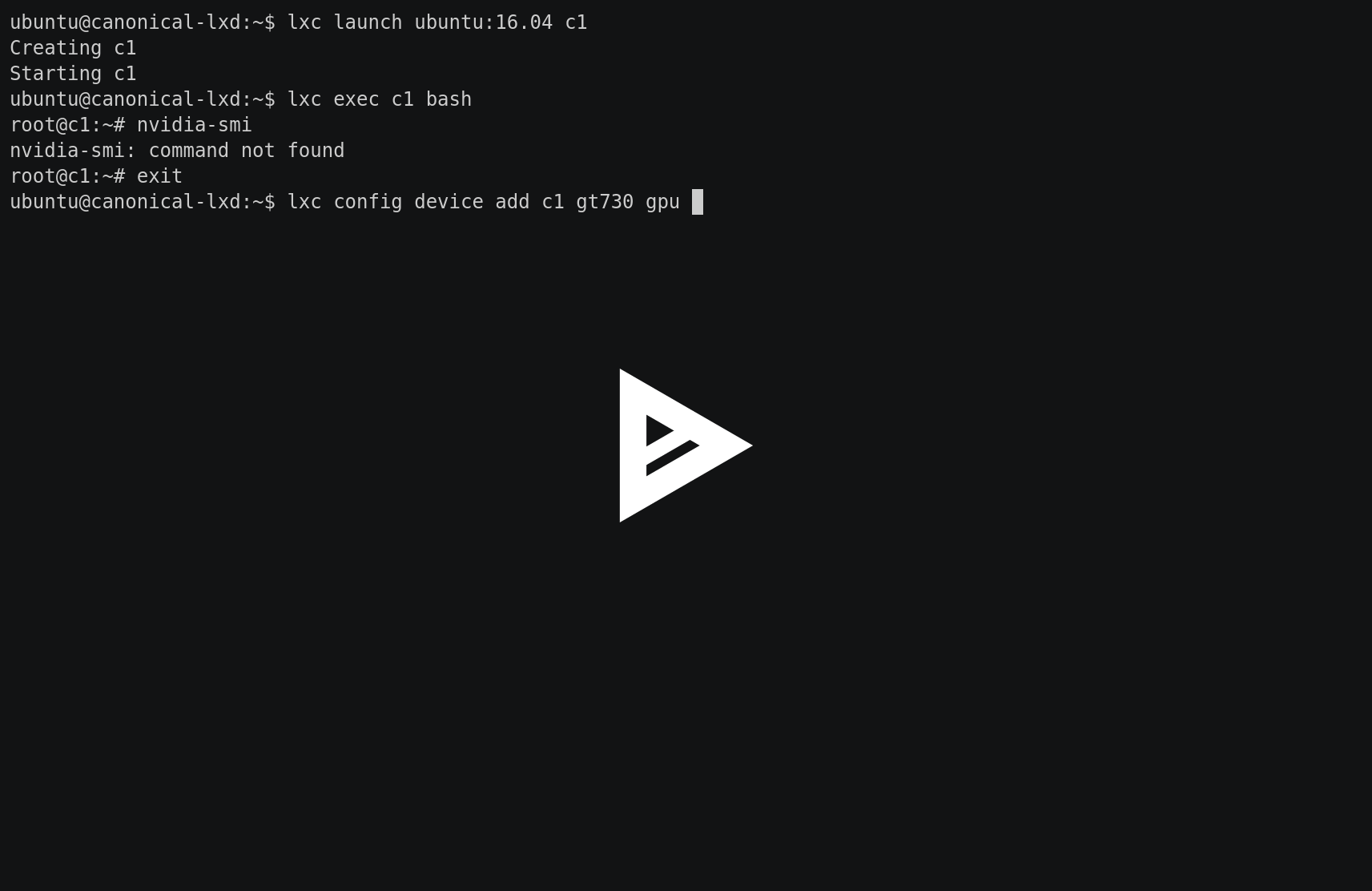Introduction
The LXD team is pleased to announce the release of LXD 3.0.0!
This is the second LTS release for the LXD project and will be supported until June 2023.
New features (since 2.21)
LXD 3.0 is going to be our main LTS release for the next two years, receiving frequent bugfix updates backported from the current feature release.
We spent over 3 months since the LXD 2.21 release to land all the features we wanted to see in LXD 3.0 and clean up a lot of existing code to make it maintainable for the duration of the LTS, below are the main highlights.
Clustering
The biggest new feature for LXD 3.0 is the introduction of clustering support.
This allows for identically configured LXD servers to be joined together as part of a cluster, appearing to the outside world as one big LXD server.
The LXD database is replicated using dqlite (a combination of sqlite3 and raft), making it so that 3 of the cluster members have a copy of the entire database at any given time.
No special system configuration or services are required to setup LXD clustering, all you need is a few available machines or VMs with similar network and storage properties, then lxd init will walk you through the process of creating the cluster and then joining some servers into it.
Here’s a short recording of setting up a LXD cluster on 3 nodes using MAAS to allocate machines and networks:
The main contributor for this feature, Free Ekanayaka also gave a longer presentation on LXD clustering at FOSDEM 2018 which you can check out here:
You can also check the documentation here: Linux Containers - LXD - Has been moved to Canonical
Physical to container migration with lxd-p2c
A new tool called lxd-p2c makes it possible to import a system’s filesystem into a LXD container using the LXD API.
After building a copy of the tool, the resulting binary can be transferred to any system that you want to turn into a container. Point it to a remote LXD server and the entire system’s filesystem will be transferred over the LXD migration API and a new container be created.
The main contributor for this feature, Stéphane Graber, also gave a presentation about it at FOSDEM 2018, the video is available here:
Support for NVIDIA runtime passthrough
A common issue for those using NVIDIA GPUs inside containers is the requirement to keep the userspace libraries in sync with the kernel driver.
This is made particularly difficult if the container’s owner isn’t also the host’s owner as the two are then likely to become out of sync at any time and without warning.
A newly introduced nvidia.runtime container configuration key, combined with a copy of the nvidia-container-cli tool and liblxc 3.0 now makes it possible to automatically detect all the right bits on the host system and pass them into the container at boot time.
This lets you save a lot of space and greatly simplifies maintenance.
Hotplug support for unix-char and unix-block devices
A new required property has been added to all unix type devices. When set to false, LXD will wait until the requested path is available on the host before automatically passing it into the container.
This allows for something like this:
lxc config device add c1 ttyUSB0 unix-char path=/dev/ttyUSB0 required=false
The c1 container will now get access to that USB serial device as soon as it’s plugged into the system and it will automatically be removed from the container when unplugged.
Local copy/move of storage volumes
It’s now possible to copy and move custom storage volumes between storage pools.
stgraber@castiana:~$ lxc storage volume copy ssd/example default/example
Storage volume copied successfully!
stgraber@castiana:~$ lxc storage volume move ssd/example default/example
Storage volume moved successfully!
Remote transfer of custom storage volumes
A new storage migration API was introduced allowing for the exact same operations as shown above to work between LXD servers as well, using the same syntax as would be used for container migration.
proxy device type to forward network connections
The new proxy device type allows for forwarding TCP connections between host and containers.
For example, to forward any connection to port 80 on the host to container c1 on it’s localhost IP on port 80:
lxc config device add c1 http proxy listen=tcp:0.0.0.0:80 connect=tcp:127.0.0.1:80
Events through /dev/lxd
The REST API endpoint exposed inside the container can now be used to receive events whenever a configuration key or device is added, removed or modified.
root@c1:~# curl -i -N -H "Connection: Upgrade" -H "Upgrade: websocket" --header "Sec-WebSocket-Version: 13" --header "Sec-WebSocket-Key: SGVsbG8sIHdvcmxkIQ==" --unix-socket /dev/lxd/sock lxd/1.0/events
HTTP/1.1 101 Switching Protocols
Upgrade: websocket
Connection: Upgrade
Sec-WebSocket-Accept: qGEgH3En71di5rrssAZTmtRTyFk=
{"metadata":{"key":"user.foo","old_value":"","value":"bar"},"timestamp":"2018-04-02T23:58:54.433992023-04:00","type":"config"}
{"metadata":{"action":"added","config":{"path":"/home","source":"/home","type":"disk"},"name":"home"},"timestamp":"2018-04-02T23:59:25.65007597-04:00","type":"device"}
Switched command line parser
Our previous command line parser, gnuflag, didn’t match our command line structure particularly well, causing confusing help and error messages. We have now transitioned to using the cobra command line parser, joining a number of other major Go projects.
Process count column in lxc list
An optional “processes” column was added to lxc list showing the number of processes running inside the container.
stgraber@castiana:~$ lxc list -c nsN c1
+------+---------+-----------+
| NAME | STATE | PROCESSES |
+------+---------+-----------+
| c1 | RUNNING | 33 |
+------+---------+-----------+
lxc storage info sub-command
A new info subcommand was added as a way to get easy human readable information about a storage pool:
stgraber@castiana:~$ lxc storage info ssd
info:
description: ""
driver: dir
name: ssd
space used: 9.29GB
total space: 173.12GB
used by: {}
Option for alternate IPv4 gateway
A new ipv4.dhcp.gateway option is now available for LXD managed bridges. This lets you set a gateway other than LXD itself and can be useful when mixing LXD bridges with physical networks.
Support for symlinks in file transfer
When doing recursive file transfers including some symlinks, those will be properly created as symlinks on the target, rather than the content of the file they point to be pushed or pulled.
Pretty rendering of log entries in lxc monitor
The LXD log messages have always been available over the event interface, accessible through the lxc monitor tool. However those raw events were sometimes pretty hard to read.
The command line client now knows how to filter and re-format those log events to look exactly as if you were looking at the server’s log output.
stgraber@castiana:~$ lxc monitor --pretty --loglevel=info --type=logging
INFO[04-02|22:57:39] Stopping container action=stop created="2018-02-27 18:02:02 -0500 EST" ephemeral=false name=snapcraft stateful=false used="2018-03-29 15:33:05 -0400 EDT"
INFO[04-02|22:57:40] Stopped container action=stop created="2018-02-27 18:02:02 -0500 EST" ephemeral=false name=snapcraft stateful=false used="2018-03-29 15:33:05 -0400 EDT"
INFO[04-02|22:57:40] Starting container action=start created="2018-02-27 18:02:02 -0500 EST" ephemeral=false name=snapcraft stateful=false used="2018-03-29 15:33:05 -0400 EDT"
INFO[04-02|22:57:41] Started container action=start created="2018-02-27 18:02:02 -0500 EST" ephemeral=false name=snapcraft stateful=false used="2018-03-29 15:33:05 -0400 EDT"
lxc network list-leases sub-command
DHCP leases on LXD managed bridges can now be queried directly through the API and the command line tool.
stgraber@castiana:~$ lxc network list-leases lxdbr0
+-----------+-------------------+---------------+---------+
| HOSTNAME | MAC ADDRESS | IP ADDRESS | TYPE |
+-----------+-------------------+---------------+---------+
| bar | 00:16:3e:e0:36:3a | 10.166.11.185 | DYNAMIC |
+-----------+-------------------+---------------+---------+
| snapcraft | 00:16:3e:be:f1:87 | 10.166.11.120 | DYNAMIC |
+-----------+-------------------+---------------+---------+
lxc alias command
It’s now possible to list, create and delete command line aliases directly from the command line tool, rather than having to manually edit the configuration file.
stgraber@castiana:~$ lxc alias list
+--------+-------------------------------------------+
| ALIAS | TARGET |
+--------+-------------------------------------------+
| delete | delete -f |
+--------+-------------------------------------------+
| ls | list -c ns46S |
+--------+-------------------------------------------+
| ubuntu | exec @ARGS@ -- sudo --login --user ubuntu |
+--------+-------------------------------------------+
lxc config device override sub-command
To override a particular option of a device that’s inherited from a profile, such as the default network interface, you need to create a device that’s local to the container and uses the same name as the one from the profile. This device will then take priority over the one coming from the profile and let you set any configuration you want.
To simplify this process, this can all be done now by using lxc config device override, passing it the container, device and configuration keys that should be changed.
stgraber@castiana:~$ lxc launch ubuntu:16.04 c1
Creating c1
Starting c1
stgraber@castiana:~$ lxc config device override c1 eth0 ipv4.address=10.166.11.42
Device eth0 overridden for c1
stgraber@castiana:~$ lxc restart c1
stgraber@castiana:~$ lxc list c1
+------+---------+---------------------+----------------------------------------------+------------+-----------+
| NAME | STATE | IPV4 | IPV6 | TYPE | SNAPSHOTS |
+------+---------+---------------------+----------------------------------------------+------------+-----------+
| c1 | RUNNING | 10.166.11.42 (eth0) | 2001:470:b368:4242:216:3eff:fed1:aff3 (eth0) | PERSISTENT | 0 |
+------+---------+---------------------+----------------------------------------------+------------+-----------+
Operations now have a description
A new description field is now present in the API for all background operations and is exposed in the command line tool.
stgraber@castiana:~$ lxc operation list
+--------------------------------------+-----------+---------------------+---------+------------+----------------------+
| ID | TYPE | DESCRIPTION | STATUS | CANCELABLE | CREATED |
+--------------------------------------+-----------+---------------------+---------+------------+----------------------+
| 343b1700-c0bd-44fa-8b1f-e6a8fdb91b42 | WEBSOCKET | Migrating container | RUNNING | NO | 2018/04/03 02:51 UTC |
+--------------------------------------+-----------+---------------------+---------+------------+----------------------+
| 65494c6e-7643-4ed5-8abf-497e57cfdd5c | WEBSOCKET | Executing command | RUNNING | NO | 2018/04/03 02:51 UTC |
+--------------------------------------+-----------+---------------------+---------+------------+----------------------+
lifecycle type events
A new event class called lifecycle has been introduced, to provide much easier tracking of what LXD is doing from scripts or other API clients, without having to interpret LXD’s log messages.
stgraber@castiana:~$ lxc monitor --type=lifecycle
metadata:
action: container-updated
source: /1.0/containers/bar
timestamp: "2018-04-02T22:53:06.742745596-04:00"
type: lifecycle
metadata:
action: container-started
source: /1.0/containers/bar
timestamp: "2018-04-02T22:53:07.234066242-04:00"
type: lifecycle
metadata:
action: container-shutdown
source: /1.0/containers/bar
timestamp: "2018-04-02T22:53:19.885795751-04:00"
type: lifecycle
metadata:
action: container-deleted
source: /1.0/containers/bar
timestamp: "2018-04-02T22:53:23.813480386-04:00"
type: lifecycle
Requirements
LXD 3.0 now requires Go 1.9 or higher. While it may be possible to build it with an older version at this point, there is no guarantee that we won’t start making use of newer Go functions in later bugfix releases.
Support and upgrade
LXD 3.0.0 will be supported until June 2023 and our current LTS release, LXD 2.0 will now switch to a slower maintenance pace, only getting critical bugfixes and security updates.
Users of the LXD feature branch (currently at 2.21) should update to 3.0 to keep being supported and get all the bugfixes and new features that LXD 3.0 provides.
Users of the LXD LTS branch (2.0.11) can choose to stay on LXD 2.0 and keep getting critical security fixes or upgrade to LXD 3.0. Those using LXD LTS in critical production environments will likely want to start upgrading a few test systems to LXD 3.0 to check for any potential issue and then upgrade the rest of their machines after LXD 3.0.1 is released.
Availability as a snap package from upstream
The recommended way to install and keep LXD up to date is by using the upstream provided snap package. This ensures that all systems are running the exact same copy of LXD and simplifies the bug reporting and debugging process.
For the LXD snap, 3 tracks are provided:
- latest (latest LXD feature release, currently 3.0)
- 2.0 (previous LTS release)
- 3.0 (current LTS release)
For each of those tracks, 3 channels are maintained:
- edge (automatic, untested builds from the upstream repository)
- candidate (the future stable build, available for testing about 48h prior to promotion)
- stable (the current stable, supported build)
Users who wish to install LXD 3.0 and then get upgraded to 3.1 in a month or so, should use:
snap install lxd
Users who wish to install LXD 3.0 and then only get bugfixes and security updates, should use:
snap install lxd --channel=3.0
If running staging systems, you may want to run those on the candidate channels, using --channel=candidate and --channel=3.0/candidate respectively.
Switching between tracks and channels is possible by using snap refresh but note that LXD doesn’t support downgrading and will fail to start if you attempt it.
Downloads
- Main release tarball: lxd-3.0.0.tar.gz
- GPG signature: lxd-3.0.0.tar.gz.asc
Contributors
The LXD 3.0.0 release was brought to you by a total of 18 contributors.



